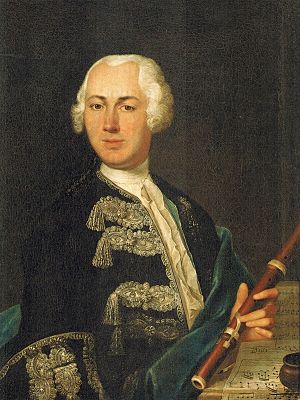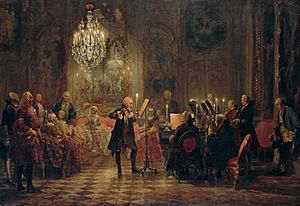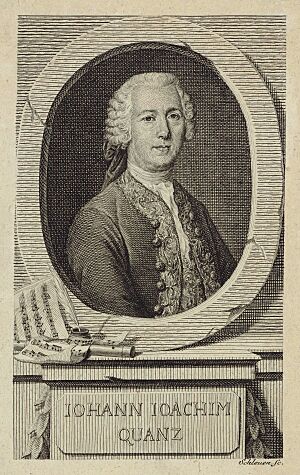Johann Joachim Quantz facts for kids
Quick facts for kids
Johann Joachim Quantz
|
|
|---|---|

Portrait by Johann Friedrich Gerhard, 1735
|
|
| Born | 30 January 1697 Scheden, Germany
|
| Died | 12 July 1773 (aged 76) Potsdam, Germany
|
| Occupation |
|
|
Notable work
|
List of compositions |
| Signature | |
 |
|
Johann Joachim Quantz (born January 30, 1697 – died July 12, 1773) was a German composer, flutist, and flute maker. He lived during the late Baroque period. A big part of his career was spent working for Frederick the Great, the King of Prussia.
Quantz wrote many pieces for the flute, like sonatas and concertos. He also wrote an important book called On Playing the Flute. This book taught people how to play the flute well. Famous composers like Bach, Haydn, and Mozart knew and liked his music.
Contents
Life Story of Quantz
Early Years and Musical Training (1697–1723)
Johann Joachim Quantz was born in a place called Oberscheden, near Göttingen, in Germany. His father was a blacksmith. Sadly, his father died when Johann was almost 11 years old.
At first, his father wanted him to become a blacksmith too. But after his father passed away, Quantz could choose his own path. From 1708 to 1713, he began learning music from his uncle, Justus Quantz. His uncle was a town musician in Merseburg. He also studied with his cousin's husband, Johann Friedrich Kiesewetter, who was an organist.
Starting in 1714, Quantz studied how to compose music. He carefully looked at the music of famous composers to learn their styles.
In 1716, he joined a town band in Dresden. The next year, he studied counterpoint (a way of combining melodies) with Jan Dismas Zelenka. In 1718, he became an oboist in a new band in Dresden. This band belonged to August II, who was the Elector of Saxony and King of Poland.
Quantz realized he couldn't get a higher position as an oboist. So, he decided to focus on the flute. In 1719, he briefly studied the flute with Pierre-Gabriel Buffardin. Buffardin was the main flutist in the Royal Orchestra. Quantz also became good friends with Johann Georg Pisendel, the concertmaster of the Royal Orchestra. Pisendel greatly influenced Quantz's musical style.
Traveling Europe and Meeting Royalty (1724–1727)
Between 1724 and 1727, Quantz traveled around Europe. This trip was like a final step in his music education. He went to Rome and studied counterpoint with Francesco Gasparini. In Naples, he met Alessandro Scarlatti, another famous composer.
In Paris, he became friends with Michel Blavet, a flutist. In London, Handel encouraged him to stay there.
In 1728, Crown Prince Frederick the Great visited Dresden. He met and played music with Pisendel and Quantz. Frederick's mother, the Queen of Prussia, was very impressed by Quantz. She wanted to hire him to teach her son.
King August II didn't want Quantz to leave his court. However, he allowed Quantz to visit Berlin and Bayreuth twice a year. In 1737, Quantz married Anna Rosina Carolina Schindler. Quantz continued to work at the Saxon Court in Dresden until 1741.
Working for Frederick the Great (1741–1773)

When Frederick II became King of Prussia in 1740, Quantz finally accepted a job with him. He became Frederick's flute teacher, flute maker, and composer. He joined the court in Berlin in December 1741. He stayed there for the rest of his life.
Quantz started making flutes around 1739. He was very creative in designing flutes. For example, he added a second key to the flute. This helped the instrument play more in tune. King Frederick owned 11 flutes that Quantz had made.
Besides writing hundreds of sonatas and concertos, mostly for the flute, Quantz is famous for his book. It's called Versuch einer Anweisung die Flöte traversiere zu spielen (1752). In English, it's known as On Playing the Flute. This book is a very important guide for understanding how music was played in the 18th century. It also explains flute techniques from that time.
Quantz lived in Berlin and played music at Frederick's court until he died in 1773. His grandnephew, Albert Quantz, wrote a full book about his life in 1877.
Musical Works
Not many of Quantz's musical pieces were published while he was alive. Most of his works are for the transverse flute.
He wrote more than 200 sonatas and about 300 concertos for the flute. Some of these concertos were for two flutes. He also composed about 45 trio sonatas, usually for two flutes or flute and violin. Additionally, he wrote 6 quartets for flute, violin, viola, and continuo. He also created various flute duets, flute trios, and solo pieces for flute.
A complete list of Quantz's works was put together by Horst Augsbach. The letters 'QV' stand for 'Quantz Verzeichnis', which means 'Quantz Catalog'. 'Anh.' means 'Anhang' or "supplement" and is used for works whose true origin is uncertain. Since this catalog was published, more of his works have been found.
Images for kids
See also
 In Spanish: Johann Joachim Quantz para niños
In Spanish: Johann Joachim Quantz para niños



